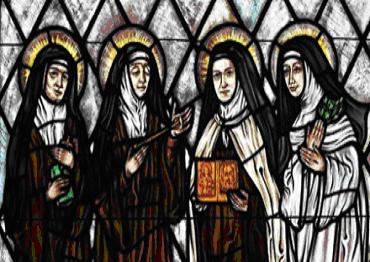 What does the Catholic Church mean by “Saint”? The Catholic Church calls some people “saint” in an official way because they offer exemplary model to the rest of us as to how to be open to God; how to say “yes to God. At first saints were proclaimed by popular acclamation. When a holy person died, the people of the local area would begin calling him or her a saint and, over time, these saints were understood to be particularly good witnesses to living the Christian life. Continue reading
What does the Catholic Church mean by “Saint”? The Catholic Church calls some people “saint” in an official way because they offer exemplary model to the rest of us as to how to be open to God; how to say “yes to God. At first saints were proclaimed by popular acclamation. When a holy person died, the people of the local area would begin calling him or her a saint and, over time, these saints were understood to be particularly good witnesses to living the Christian life. Continue reading
Category Archives: AFFC-blog
FAITH MATTERS: The Canonization of Saints
Comments Off on FAITH MATTERS: The Canonization of Saints
Posted in Adult Faith Formation, AFFC-blog
FAITH MATTERS: A Great Cloud of Witnesses: The Communion of Saints
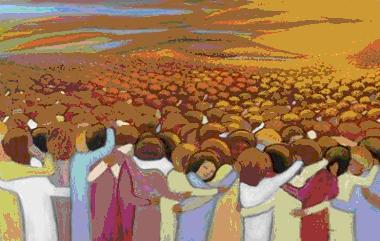 The Church teaches us that we are all a part of the communion of saints – the community of all men and women of good will, both living and dead. But this is a difficult thing to imagine, this communion of saints. Fortunately, the Bible gives us a wonderful image. Continue reading
The Church teaches us that we are all a part of the communion of saints – the community of all men and women of good will, both living and dead. But this is a difficult thing to imagine, this communion of saints. Fortunately, the Bible gives us a wonderful image. Continue reading
Comments Off on FAITH MATTERS: A Great Cloud of Witnesses: The Communion of Saints
Posted in Adult Faith Formation, AFFC-blog
FAITH MATTERS: What is a Saint?
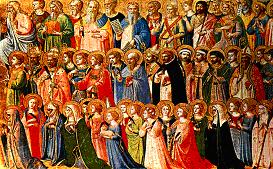 November 1st is the day on which Christians celebrate all saints, known and unknown. But what is a ‘Saint’? In St. Paul’s First Letter to the Corinthians we read: ‘To the church of God which is at Corinth, to those sanctified in Christ Jesus, called to be saints together with all those who in every place call on the name of our Lord Jesus Christ,’ (I Cor 1:2). What does St. Paul mean by use of the word ‘saint’? In other translations of the Bible, ‘called to be saints’ is translated from the original Greek as ‘called to be holy.’ So saint is a synonym for holy. Continue reading
November 1st is the day on which Christians celebrate all saints, known and unknown. But what is a ‘Saint’? In St. Paul’s First Letter to the Corinthians we read: ‘To the church of God which is at Corinth, to those sanctified in Christ Jesus, called to be saints together with all those who in every place call on the name of our Lord Jesus Christ,’ (I Cor 1:2). What does St. Paul mean by use of the word ‘saint’? In other translations of the Bible, ‘called to be saints’ is translated from the original Greek as ‘called to be holy.’ So saint is a synonym for holy. Continue reading
Comments Off on FAITH MATTERS: What is a Saint?
Posted in Adult Faith Formation, AFFC-blog
FAITH MATTERS: Marian Apparitions
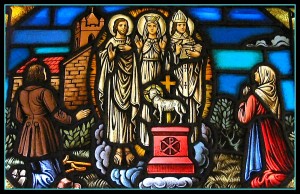 A Marian apparition is a supernatural appearance of the Virgin Mary. One of the most famous examples from our history is Mary giving St. Bernard of Clairvaux the ‘Hail Mary’. The Church treats apparitions as private revelations that can never add anything new to the faith. An authentic apparition is believed not to be a subjective experience, but a real and objective intervention of divine power. The purpose of such apparitions is to recall and emphasize some aspect of the Christian message. The Church states that cures and other miraculous events are not the purpose of Marian apparitions, but exist primarily to validate and draw attention to the message. Marian apparitions are regarded as evidence of Mary’s continuing active presence in the life of the church, through which she ‘cares for the brethren of her Son who still journey on the earth’ (Lumen Gentium, 62).The Roman Catholic Church may pronounce an apparition as worthy of belief, but belief in an apparition is never required by divine faith. According to the Church, the era of public revelation ended with the death of the last living apostle. Continue reading
A Marian apparition is a supernatural appearance of the Virgin Mary. One of the most famous examples from our history is Mary giving St. Bernard of Clairvaux the ‘Hail Mary’. The Church treats apparitions as private revelations that can never add anything new to the faith. An authentic apparition is believed not to be a subjective experience, but a real and objective intervention of divine power. The purpose of such apparitions is to recall and emphasize some aspect of the Christian message. The Church states that cures and other miraculous events are not the purpose of Marian apparitions, but exist primarily to validate and draw attention to the message. Marian apparitions are regarded as evidence of Mary’s continuing active presence in the life of the church, through which she ‘cares for the brethren of her Son who still journey on the earth’ (Lumen Gentium, 62).The Roman Catholic Church may pronounce an apparition as worthy of belief, but belief in an apparition is never required by divine faith. According to the Church, the era of public revelation ended with the death of the last living apostle. Continue reading
Comments Off on FAITH MATTERS: Marian Apparitions
Posted in Adult Faith Formation, AFFC-blog
FAITH MATTERS: Some Reflections on Catholic Devotion to Mary
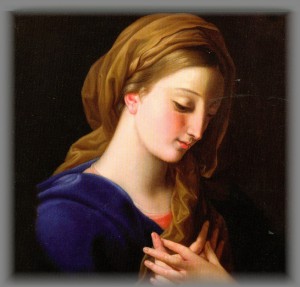 Who is ‘Mary’? As far as the gospels tell us she is the mother of Jesus. Nothing more is revealed about her; mother of Jesus is her identity. Interestingly most of the other women in the gospels are also called Mary too! This fact reminds me of how it is assumed that every Irishman’s name is Paddy or every Scotsman is called Jock, even after their true name has been given. It is as if their real name had no consequence – they have no consequence. Is this how women were viewed in Mary’s time? Apart from her motherhood, does this mean that Mary is a blank canvas upon whom the hopes and dreams (and fears) of the developing Christian Church are expressed? Continue reading
Who is ‘Mary’? As far as the gospels tell us she is the mother of Jesus. Nothing more is revealed about her; mother of Jesus is her identity. Interestingly most of the other women in the gospels are also called Mary too! This fact reminds me of how it is assumed that every Irishman’s name is Paddy or every Scotsman is called Jock, even after their true name has been given. It is as if their real name had no consequence – they have no consequence. Is this how women were viewed in Mary’s time? Apart from her motherhood, does this mean that Mary is a blank canvas upon whom the hopes and dreams (and fears) of the developing Christian Church are expressed? Continue reading
Comments Off on FAITH MATTERS: Some Reflections on Catholic Devotion to Mary
Posted in Adult Faith Formation, AFFC-blog
FAITH MATTERS: The Rosary – The Story of a Relationship
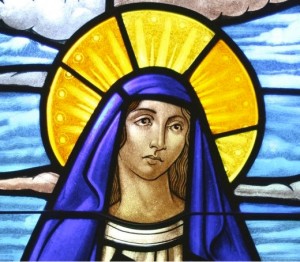 It all began when, as a child on my knees (leaning against a chair), my family would pray the Rosary during every May and October. I hated it! I knew my school friends would see this as weird (although I felt like a grown-up when it was my turn to lead everyone in a ‘decade’). Strangely though, as I grew up, whenever life was hard and I had no other words to use in prayer, I would find myself saying the Rosary. The Rosary would put me in touch with the Grace of God.
It all began when, as a child on my knees (leaning against a chair), my family would pray the Rosary during every May and October. I hated it! I knew my school friends would see this as weird (although I felt like a grown-up when it was my turn to lead everyone in a ‘decade’). Strangely though, as I grew up, whenever life was hard and I had no other words to use in prayer, I would find myself saying the Rosary. The Rosary would put me in touch with the Grace of God.
The peculiar thing was that the Rosary kept ‘turning up’ in my life, at the most unexpected times. In school history, we learnt about the Battle of Lepanto, a decisive sea battle that stemmed the advance of the Ottoman Empire into Western Europe. The pope’s forces credited the victory to Our Lady since they had implored her help before battle by praying the Rosary. Since the day of the victory was October 7, Pope Pius V named it as the feast of Our Lady of the Rosary. When I met a new friend called Jacinta at college she told me that her name was the name of one of the children who saw Our Lady at Fatima in Portugal. Next I learn that on October 13, 1917 the Lady of Fatima called herself the Queen of the Rosary and aske that everyone should say the Rosary for the conversion of the world. Then, when Pope John Paul II was shot on May 13, 1981 (coincidently May 13, 1917 was the date that Our Lady first appeared at Fatima), the Pope credited Our Lady of Fatima, the Queen of the Rosary for his recovery! My Buddhist and Hindu friends always seemed really ‘cool’ with their prayer beads – so like the Rosary beads my mother had given me (which I was too embarrassed to use). This was similar to how I was impressed by Muslims being called to pray throughout the day. Was this so very different to saying the Angelus at noon and 6pm? Later, when I learnt about meditation and practised Yoga, I couldn’t help thinking that I had been doing this since I was a little girl when I said the Rosary and focused on the events of Jesus’ life. I learned early that involving my conscious self in following the mechanics of physically ‘saying’ the Rosary allowing my ‘inner self’ to be with God as I mediated on the ‘mysteries’ such as the Annunciation, the Crucifixion, or the Resurrection.
When I married I longed for a child. For five years, I became more and more heartbroken, sure that I would never be able to have a baby. I was beyond conscious prayer but often I became aware of myself praying the Rosary quietly within myself. Finally, I was pregnant and I prayed that I would manage to have the baby. She was due on September 22nd but I didn’t go into labor until October 5th! You guessed it – our daughter was born early in the morning on October 7th, the feast of Our Lady, Queen of the Rosary! People wanted us to call her Rose or Rosaria, but she was named Grace because the Rosary has been the ‘door’ by which God’s Grace has entered my life.
Comments Off on FAITH MATTERS: The Rosary – The Story of a Relationship
Posted in Adult Faith Formation, AFFC-blog
FAITH MATTERS… Jorge Mario Bergoglio: A Life of Service to the Church
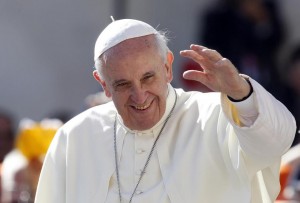
Pope Francis is a pope of firsts: he is the first pope from the Americas, he is the first Jesuit to be elected pope, and he is the first pope to take the name Francis. He is a man of deep personal faith and he is profoundly committed to the Catholic Church, and he has a different pastoral style than his predecessor, Benedict XVI. When he was first elected, many people were unfamiliar with him – many of us thought, “WHO?” when his name was first announced. To help get a sense of who Francis is, lets explore a bit of his biography and some of the theological ideas that have become associate with him so far.
Jorge Mario Bergoglio was born in Buenos Aires, Argentina on December 17, 1936. His parents were Italian immigrants. He has four siblings; his father was an accountant and his mother was a stay-at-home parent. He worked briefly as a chemical technician. He became seriously ill in 1957, developing pneumonia and eventually loosing his right lung. Shortly thereafter, in March of 1958, he entered the Jesuits. He took his first vows on March 12, 1960 and spent the next nine years as a student of philosophy and theology at the San Miguel Seminary in Buenos Aires and as a secondary school teacher. He was ordained to the priesthood on December 13, 1969. Fr. Jorge served the Jesuits in a variety of posts: as master of novices and vice chancellor of the San Miguel Seminary (1971-73), as superior of the Jesuit province of Argentina and Uruguay (1973-79), and as rector and theology teacher at Colegio Maximo (1979-85). After finishing his doctoral dissertation in Germany, he is ordained auxiliary bishop of Buenos Aires on June 27, 1992 and become coadjutor (an assisting bishop with the right to become the next bishop of a diocese) archbishop of Buenos Aires in 1997. On February 28, 1998, he is installed as Archbishop of Buenos Aires and is elevated to cardinal on February 21, 2001. On March 13, 2013, he was elected pope by a conclave of 115 cardinals.
In his few months as pope, Francis has made a significant impression on Catholics around the world. While it is obviously impossible to predict how Francis’ papacy will develop, it is interesting to note a couple of themes that are emerging so far. First and almost immediately, Pope Francis has displayed a personal style that is far simpler and less “pomp-and-circumstance-y” than his predecessors. On the evening he was elected, appeared without all of the regalia that marks a new pope, choosing just the simple white cassock. He asked the crowds to pray for him before he blessed them. Since then, he has stunned people with his acts of simplicity and humility: paying his hotel bill, choosing not to live in the papal palace, saying daily mass at the Vatican guesthouse, washing the feet of young convicts on Holy Thursday, and reaching out to greet people, especially children.
Second, Francis has reminded us of the church’s commitment to service. In choosing to name himself after St. Francis of Assisi, the pope has recalled for us that to follow Jesus means living a life of service, poverty, and simplicity. And, in living that life of service, the church is called to serve especially those who are the most marginalized and excluded – the sick, the poor, the exploited, the unloved.And third, along side of his emphases on simplicity and service, this pope is a very learned man. Like John Paul II and Benedict XVI, Pope Francis has an extensive background in theology and spent most of his career as a teacher – both at the high school level and at the graduate level. In addition, he spent a good part of his career guiding the formation of priests – both as novice master and as vice-chancellor and then rector of the seminary. Thus, to dismiss Francis as “merely a pastor” would be to ignore is long career as a teacher of theology and his commitment to ensuring that the church is well-served by its priests and theologians.
As Pope Francis continues his service as pope, we will come to understand more and more about his thoughts, his spirituality, his style, and his concerns for the church. And it will be an exciting time!
Comments Off on FAITH MATTERS… Jorge Mario Bergoglio: A Life of Service to the Church
Posted in Adult Faith Formation, AFFC-blog
FAITH MATTERS… Who is St. Francis of Assisi Anyway?
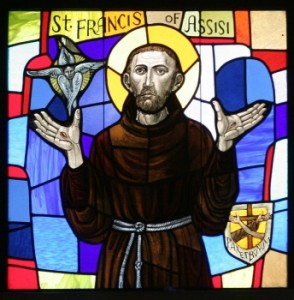
Pope Francis chose to name himself after St. Francis of Assisi. Why is this saint so popular after nearly 800 years? This reflection on St. Francis’ life might provide some clues. Why do you think St. Francis speaks so clearly to us today?
Most people have heard of St. Francis of Assisi, but how much do we actually know about him? We see his statues in gardens and have a vague idea that he was poor and liked animals, but if this is all he was, then why is he still so popular nearly 800 years after his death?
St. Francis of Assisi was born in 1181 and, at his baptism, was given the name Giovanni. His father, a wealthy silk merchant, loved all things French and gave his son the nickname Francesco. Francis had a fairly typical upbringing for a boy of his time and, as a young man, he was known to enjoy the music of the troubadours, bright clothing, rich friends, and good times. As a young adult, he became a soldier, but was captured at his first battle and spent a year as a captive.
Comments Off on FAITH MATTERS… Who is St. Francis of Assisi Anyway?
Posted in AFFC-blog
FAITH MATTERS… A New Blog from the AFFC
 Please take a moment to visit Faith Matters, a new blog from the Adult Faith Formation Commission. Each month we will explore some aspect of our shared Christian faith, with reflections written by some of our fellow parishioners and links to lots of great information from a wide variety of web resources. “Like” St. John’s on Facebook to receive regular updates and fun facts on our monthly theme.
Please take a moment to visit Faith Matters, a new blog from the Adult Faith Formation Commission. Each month we will explore some aspect of our shared Christian faith, with reflections written by some of our fellow parishioners and links to lots of great information from a wide variety of web resources. “Like” St. John’s on Facebook to receive regular updates and fun facts on our monthly theme.
This Month’s Theme: Pope Francis
Comments Off on FAITH MATTERS… A New Blog from the AFFC
Posted in Adult Faith Formation, AFFC-blog

